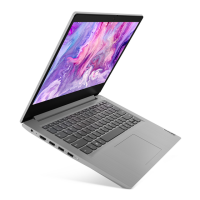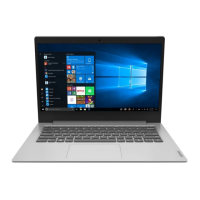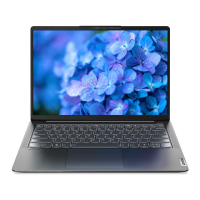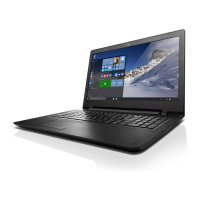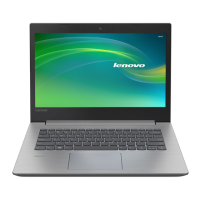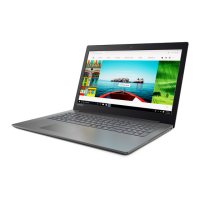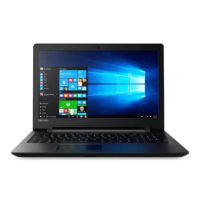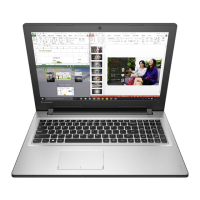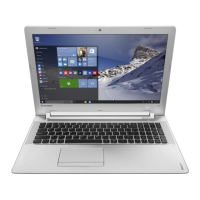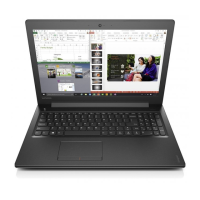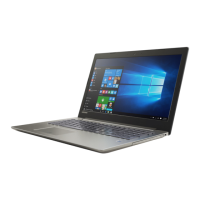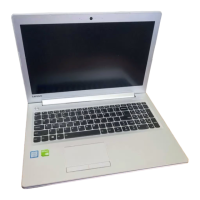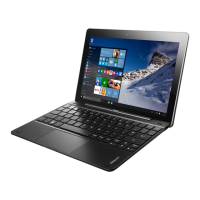
Do you have a question about the Lenovo Ideapad MIIX 300-10IBY and is the answer not in the manual?
| Processor | Intel Atom Z3735F |
|---|---|
| RAM | 2 GB |
| Storage | 32 GB eMMC |
| Battery Life | Up to 9 hours |
| Wireless | Wi-Fi 802.11 b/g/n, Bluetooth 4.0 |
| Graphics | Intel HD Graphics |
| Display | 1280 x 800 pixels |
| Weight | 615 g |
| Ports | Micro USB, Micro HDMI, MicroSD card reader, Audio combo jack |
| Camera | 2MP front-facing, 5MP rear-facing |
Identifies front camera, wireless LAN antenna, and multi-touch screen.
Explains how the display panel orientation changes based on how the device is held.
Details components on the left side: combo audio jack, microphone, USB, HDMI, power indicator, and SD card slot.
Instructions for inserting and removing micro SD cards.
Identifies tablet-keyboard dock latch and connector on the bottom view.
Details components on the rear: cameras, volume buttons, power button, and speakers.
Identifies keyboard dock connectors and system status indicators like power and caps lock.
Explains how to use function keys and lists combinations for mute, window close, touchpad, airplane mode, etc.
Details the USB port on the left side of the keyboard dock.
Details the USB port on the right side of the keyboard dock.
Explains how the ideapad MIIX 300-10IBY can be used as a tablet or notebook.
Instructions on how to detach the tablet from the keyboard dock using the release button.
Procedures for initial OS setup: license agreement, internet connection, registration, and user account.
Describes the two main interfaces in Windows 8.1: Start screen and desktop, and how to switch between them.
Explains the five Windows 8.1 charms (Search, Share, Start, Devices, Settings) and how to display them.
Enables sending links, photos, and social network updates from within apps.
Provides a way to navigate to the Start screen from any application.
Allows connecting or sending files to external devices for play, print, or project.
Facilitates basic tasks like adjusting volume or shutting down the computer.
Guides on how to put the computer to sleep or shut it down using power button or charms.
Explains how the display panel accepts input via multi-touch screen.
Details gestures like Zoom and Rotate for interacting with apps and content.
Explains swipe gestures from screen edges to access task bars, split-screen, or charms.
Details swipe gestures from left and right edges for app management and charms display.
Steps to enable wireless connection, disable Airplane mode, and connect to available networks.
Information on accessing Windows Help and Support file and the Help+Tips app.
Introduces Push-button reset as a tool to restore the operating system to its original state.
Fixes software problems by reinstalling the factory configuration, preserving data and settings.
Prepares the computer for transfer of ownership by reinstalling factory default configuration and user data.
Details methods to launch Push-button reset using hardware buttons or Windows PC settings.
Lists common user questions categorized for easy reference.
Guides on where to find safety precautions, hardware specifications, and warranty information.
Information on where to download device drivers from the Lenovo support website.
Instructions on how to contact the customer support center.
Troubleshooting for blank screens when turning on the computer.
Troubleshooting for computer resuming from sleep mode or entering sleep immediately.
Troubleshooting for blank, unreadable, distorted screens, and incorrect characters.
Addresses issues where no sound is heard from speakers even when volume is up.
Troubleshooting for unexpected shutdowns or operation issues related to the battery status.
Guidance for when the Microsoft Windows operating system fails to start.
Addresses issues with restoring the system partition to factory default.
Troubleshooting for when the computer does not respond, including force shutdown procedures.
